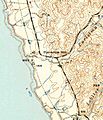Purissima, California facts for kids
Quick facts for kids
Purissima, California
|
|
|---|---|
| Country | United States |
| State | California |
| County | San Mateo |
| Time zone | UTC-8 (Pacific (PST)) |
| • Summer (DST) | UTC-7 (PDT) |
Purissima is a ghost town in southwestern San Mateo County, California. A ghost town is a place where most people have left, leaving behind empty buildings. Purissima is located near where State Route 1 and Verde Road meet.
The name Purísima comes from Spanish and means "purest." It often refers to La Purísima Concepción, which is the Immaculate Conception of the Virgin Mary. The town's name was misspelled in English, leading to the "ss" at the end. Purissima was also the setting for a 1958 crime novel called 'The Doomsters' by Ross Macdonald.
Contents
History of Purissima: A Vanished Town
Purissima was one of the first settlements along the coast of San Mateo County. It was founded in the early 1850s in a farming area. The village was located on land that once belonged to José María Alviso, called Rancho Cañada de Verde y Arroyo de la Purisima. It was about four miles (6 km) south of Half Moon Bay.
Early Challenges and Flooding
In January 1862, Purisima Creek badly flooded the community. This was the same month that many parts of northern California experienced their worst floods ever. Some fields and buildings in Purissima were washed away by the water.
Henry Dobbel and the Town's Growth
Henry Dobbel was an important figure in Purissima's history. He was born in Holstein, Germany, in 1829. He came to California in 1845. After various jobs, he married Margaret Roverkamf-Schroeder, who was also from Germany.
In the 1860s, the Dobbels bought 1,000 acres (4.0 km2) of land. They built a large, fancy house with 17 rooms. It even had modern features like gas lighting and running water. Dobbel hired 50 men to grow crops like wheat, barley, and potatoes.
By the early 1870s, Purissima was a busy place. It had a post office, several stores, a school, and a hotel called Purissima House. A lumber mill was built nearby to process redwood trees from the Santa Cruz Mountains.
Oil Discovery and Financial Troubles
Oil was found near the village in the 1880s. However, the oil production was very small, only about 20 barrels a day. So, the hopes for an oil boom quickly faded. The U.S. Geological Survey later noted that other attempts to find oil in the area also produced very little.
Henry Dobbel faced financial problems after buying the general store. He let many customers buy things on credit, meaning they could pay later. Then, a series of crop failures hit the area. This affected Dobbel and the entire community. Henry Dobbel went bankrupt and sold his property in 1890 to Henry Cowell. Henry Dobbel and his wife are buried in the village cemetery.
The Decline of Purissima
The Ocean Shore Railroad operated from San Francisco to Tunitas Creek between 1907 and 1920. It included a stop at Purissima. The Purissima Post Office opened in 1868, closed in 1869, then reopened in 1872, and finally closed for good in 1901.
Some buildings in Purissima were still standing in the 1930s. However, the town was mostly abandoned before World War II. Maps from the 1940s still showed the "Purissima School." At that time, State Route 1 went directly through the town. Today, Highway 1 runs further west. Verde Road is actually the original path of Highway 1. The cemetery is still there, hidden in the woods.
In 1939, a guidebook described Purissima as "ghostly and deserted." It mentioned the "weathered gray buildings" with broken windows and falling stairs.
There isn't one clear reason why Purissima became a ghost town. Its remote location likely caused people to move to bigger towns like Half Moon Bay. The failure of the Ocean Shore Railroad, which was meant to improve access to the coast, might have also hurt the town.
Today, all that remains of Purissima are the cemetery and a small part of the old school. Several farms surround the area. The region has grown more recently, with towns like Montara and Half Moon Bay expanding. However, Purissima had already disappeared long ago.
Purisima Creek: A Natural Feature
Near the town site is Purisima Creek. Purisima Creek Road follows the creek for some distance, heading towards the Santa Cruz Mountains in the east. You can sometimes see beautiful waterfalls along the creek, especially during certain seasons. Spanish explorers originally named the creek "Arroyo de la Purissima."
Images for kids









